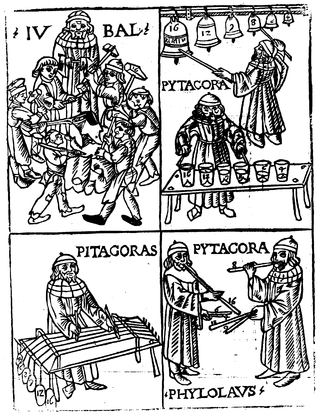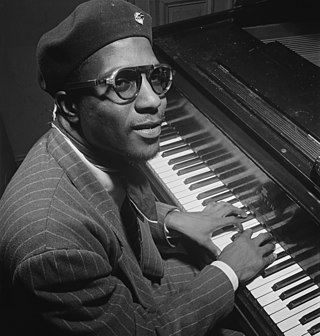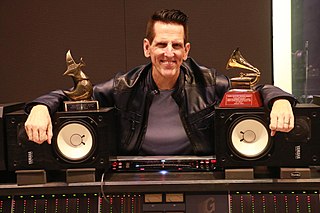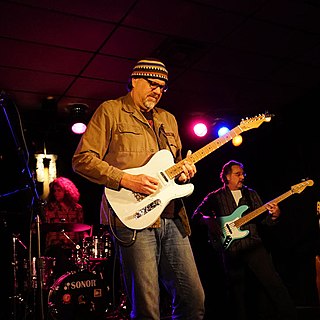
The major scale is one of the most commonly used musical scales, especially in Western music. It is one of the diatonic scales. Like many musical scales, it is made up of seven notes: the eighth duplicates the first at double its frequency so that it is called a higher octave of the same note.

In music, harmony is the concept of combining different sounds together in order to create new, distinct musical ideas. Theories of harmony seek to describe or explain the effects created by distinct pitches or tones coinciding with one another; harmonic objects such as chords, textures and tonalities are identified, defined, and categorized in the development of these theories. Harmony is broadly understood to involve both a "vertical" dimension (frequency-space) and a "horizontal" dimension (time-space), and often overlaps with related musical concepts such as melody, timbre, and form.

Music theory is the study of the practices and possibilities of music. The Oxford Companion to Music describes three interrelated uses of the term "music theory": The first is the "rudiments", that are needed to understand music notation ; the second is learning scholars' views on music from antiquity to the present; the third is a sub-topic of musicology that "seeks to define processes and general principles in music". The musicological approach to theory differs from music analysis "in that it takes as its starting-point not the individual work or performance but the fundamental materials from which it is built."
In music, a whole-tone scale is a scale in which each note is separated from its neighbors by the interval of a whole tone. In twelve-tone equal temperament, there are only two complementary whole-tone scales, both six-note or hexatonic scales. A single whole-tone scale can also be thought of as a "six-tone equal temperament".
In a musical composition, a chord progression or harmonic progression is a succession of chords. Chord progressions are the foundation of harmony in Western musical tradition from the common practice era of Classical music to the 21st century. Chord progressions are the foundation of popular music styles, traditional music, as well as genres such as blues and jazz. In these genres, chord progressions are the defining feature on which melody and rhythm are built.

In music theory, the circle of fifths is a way of organizing the chromatic pitches of a particular tuning or temperament as a sequence of perfect fifths. If C is chosen as a starting point, the sequence is: C, G, D, A, E, B, F♯, C♯, G♯, D♯, A♯, E♯, B♯, and so on. This order places the most closely related key signatures adjacent to one another. It is usually illustrated in the form of a circle.

In music, extended chords are certain chords or triads with notes extended, or added, beyond the seventh. Ninth, eleventh, and thirteenth chords are extended chords. The thirteenth is the farthest extension diatonically possible as, by that point, all seven tonal degrees are represented within the chord. In practice however, extended chords do not typically use all the chord members; when it is not altered, the fifth is often omitted, as are notes between the seventh and the highest note, unless they are altered to give a special texture.

In music or music theory, a thirteenth is the note thirteen scale degrees from the root of a chord and also the interval between the root and the thirteenth. The thirteenth is most commonly major or minor.
Coltrane changes are a harmonic progression variation using substitute chords over common jazz chord progressions. These substitution patterns were first demonstrated by jazz musician John Coltrane on the albums Bags & Trane and Cannonball Adderley Quintet in Chicago. Coltrane continued his explorations on the 1960 album Giant Steps and expanded on the substitution cycle in his compositions "Giant Steps" and "Countdown", the latter of which is a reharmonized version of Eddie Vinson's "Tune Up". The Coltrane changes are a standard advanced harmonic substitution used in jazz improvisation.

In music, a guitar chord is a set of notes played on a guitar. A chord's notes are often played simultaneously, but they can be played sequentially in an arpeggio. The implementation of guitar chords depends on the guitar tuning. Most guitars used in popular music have six strings with the "standard" tuning of the Spanish classical guitar, namely E–A–D–G–B–E' ; in standard tuning, the intervals present among adjacent strings are perfect fourths except for the major third (G,B). Standard tuning requires four chord-shapes for the major triads.

Jazz harmony is the theory and practice of how chords are used in jazz music. Jazz bears certain similarities to other practices in the tradition of Western harmony, such as many chord progressions, and the incorporation of the major and minor scales as a basis for chordal construction. In jazz, chords are often arranged vertically in major or minor thirds, although stacked fourths are also quite common. Also, jazz music tends to favor certain harmonic progressions and includes the addition of tensions, intervals such as 9ths, 11ths, and 13ths to chords. Additionally, scales unique to style are used as the basis of many harmonic elements found in jazz. Jazz harmony is notable for the use of seventh chords as the basic harmonic unit more often than triads, as in classical music. In the words of Robert Rawlins and Nor Eddine Bahha, "7th chords provide the building blocks of jazz harmony."

Jazz piano is a collective term for the techniques pianists use when playing jazz. The piano has been an integral part of the jazz idiom since its inception, in both solo and ensemble settings. Its role is multifaceted due largely to the instrument's combined melodic and harmonic capabilities. For this reason it is an important tool of jazz musicians and composers for teaching and learning jazz theory and set arrangement, regardless of their main instrument. By extension the phrase 'jazz piano' can refer to similar techniques on any keyboard instrument.
Jazz chords are chords, chord voicings and chord symbols that jazz musicians commonly use in composition, improvisation, and harmony. In jazz chords and theory, most triads that appear in lead sheets or fake books can have sevenths added to them, using the performer's discretion and ear. For example, if a tune is in the key of C, if there is a G chord, the chord-playing performer usually voices this chord as G7. While the notes of a G7 chord are G–B–D–F, jazz often omits the fifth of the chord—and even the root if playing in a group. However, not all jazz pianists leave out the root when they play voicings: Bud Powell, one of the best-known of the bebop pianists, and Horace Silver, whose quintet included many of jazz's biggest names from the 1950s to the 1970s, included the root note in their voicings.

In music, the dominant 7♯9 chord is a chord built by combining a dominant seventh, which includes a major third above the root, with an augmented second, which is the same pitch, albeit given a different note name, as the minor third degree above the root. This chord is used in many forms of contemporary popular music, including jazz, funk, R&B, rock and pop. As a dominant chord in diatonic harmony, it most commonly functions as a turnaround chord, returning to the tonic.

Donald James Moen is an American singer, pianist, and songwriter, specializing in Christian worship music.
In jazz harmony, a So What chord is a particular 5-note chord voicing. From the bottom note upwards, it consists of three perfect fourth intervals followed by a major third interval. It was employed by Bill Evans in the "'amen' response figure" to the head of the Miles Davis tune "So What".

Jean Marc Belkadi is a French-born, American jazz fusion guitarist known for his improvisational soloing technique.
A chordioid, also called chord fragment or fragmentary voicing or partial voicing, is a group of musical notes which does not qualify as a chord under a given chord theory, but still useful to name and reify for other reasons.

Tom Brooks is an American music producer, arranger, engineer, and conductor. He is keyboardist/Music Director for Alan Parsons and the Alan Parsons Live Project, and is the founding producer of Integrity Music and the Hosanna Music series distributed by Sony. For his production work Brooks has been awarded 6 Platinum Albums, 12 Gold Albums, a Latin Grammy Award, and a GMA Dove Award. He is Director of the Center for Commercial Music at California Baptist University and Music Professor at Hope International University. His "Language of Music" book is published by Hal Leonard Publishing.

Greg Koch is an American guitarist from Wauwatosa, Wisconsin. In April 2012 Fender Musical Instruments Corporation named Koch one of the top 10 unsung guitarists. In April 2023 The Wisconsin Area Music Industry announced that Koch would be inducted into the WAMI Hall of Fame














